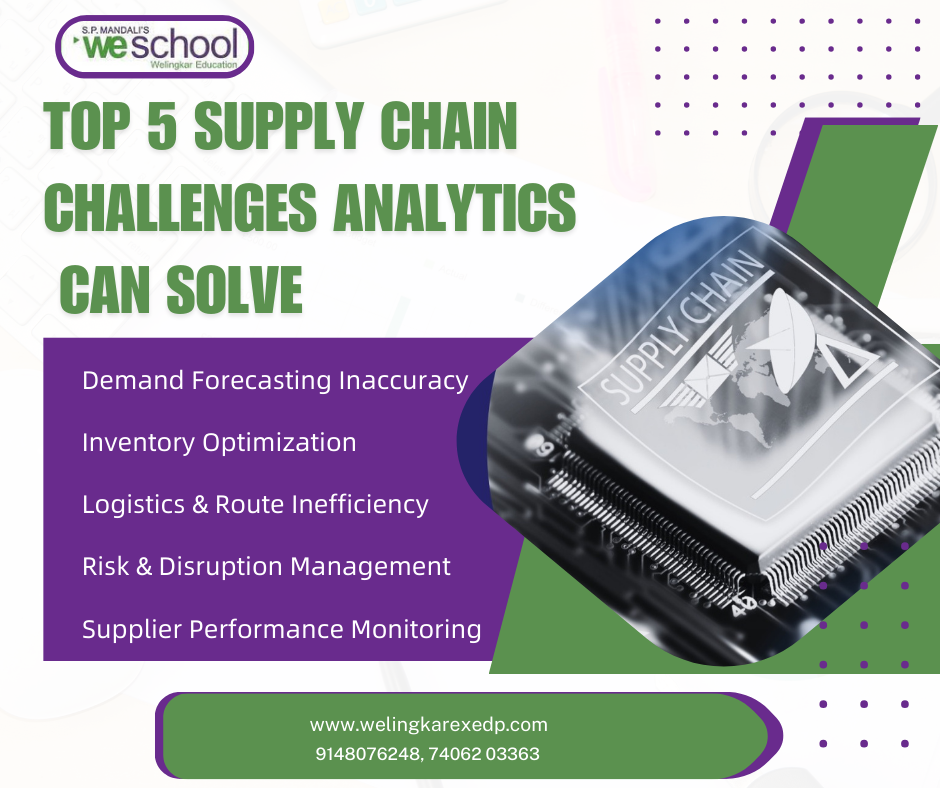In 2025, data is no longer information; it is the basis of all smart decisions. Analytics in business has transformed business growth and innovation in terms of marketing strategies and pricing models to hiring plans and logistics. Data leveraging companies are more successful because they are quicker, minimize wastes, and realize tangible success.
In Welingkar Institute of Management Development and Research (WeSchool) analytics is not learned as a theory but it is a discipline of decision-making. The programs of the institute assist the professionals to turn information into wisdom, facts into policies and trends into improvements.
What Is Analytics in Business?
It is vital to establish the definition of what is analytics in business before knowing its value.
It can be defined as the logical application of data, statistical models and technology to unravel insights that enhance better decisions. It transforms raw information into actionable results and organizations are in a position to predict trends, manage risks and measure performance accurately.
What is analytics in business combine several sources (sales, operations, finance and HR) into a single consistent image as compared to isolated reports. This coherent perception, when looked upon in a certain way, assists businesses in determining what is working, what is not and where to invest in the future.
Why Are Analytics Important in Business?
The importance of analytics in business cannot be overstated in today’s data-centric world. Every decision from pricing to product launches relies on interpreting data effectively. Here are reasons why analytics is crucial for modern organizations.
1. Turning Information into Actionable Insights
What is analytics in business if not a bridge between data and decision? Analytics transforms complex information into understandable insights that guide business strategy. It helps leaders see patterns, forecast trends, and identify risks. Instead of relying on assumptions, organizations act based on real evidence, increasing both speed and precision in decision-making.
2. Strengthening Strategic Decision-Making
One of the biggest reasons why analytics are important is their impact on strategic clarity. Analytics supports leaders in setting measurable goals, tracking KPIs, and refining corporate strategies using real data. When decision-makers have accurate visuals and forecasts, they allocate budgets efficiently and drive initiatives that create sustainable business growth.
3. Enhancing Transparency and Accountability
A data-driven environment promotes transparency. Dashboards and business analytics solutions allow all departments to view the same metrics in real time. This eliminates version conflicts and ensures that decisions are based on shared facts. Analytics builds accountability by showing who owns which results, creating a culture where performance is visible and measurable.
4. Supporting Innovation and Market Adaptability
The future of business analytics is about helping companies stay adaptable. Analytics allows organizations to track changing consumer behaviors, emerging technologies, and competitive trends. These insights inspire new product ideas, faster pivots, and smarter investments. By integrating data into R&D and marketing, businesses remain innovative and responsive to market needs.
5. Improving Financial Planning and Resource Allocation
Accurate financial forecasting is another reason why data analytics is important. Analytics tools analyze historical spending, revenue patterns, and cost fluctuations to create reliable projections. This enables CFOs and managers to plan budgets with greater confidence, ensuring funds are directed where they yield the most impact and minimizing financial risks.
Advantages of Business Analytics
While importance highlights the “why,” the advantages of business analytics explain the “how.” These benefits show how analytics converts data into measurable value for organizations across industries.
1. Faster and Smarter Decisions
Through analytics in business, companies gain access to real-time insights that speed up decision-making. Automated reports, visual dashboards, and predictive models allow teams to act quickly. Whether adjusting pricing, optimizing supply chains, or reallocating marketing budgets, faster data access means quicker and more accurate responses to change.
2. Reduced Risk and Increased Resilience
One of the major benefits of business analytics is early risk detection. Predictive analytics identifies possible disruptions like demand drops, supplier delays, or cost spikes before they occur. Businesses can prepare mitigation strategies in advance, improving resilience. Data-backed foresight also minimizes the uncertainty that often accompanies major business decisions.
3. Improved Customer Experience
With business analytics solutions, companies can deeply understand customer behavior and preferences. Analytics tracks buying patterns, service feedback, and engagement trends to personalize offerings. The result is stronger brand loyalty and higher customer satisfaction. In today’s competitive market, customer-centric decisions powered by analytics ensure consistent growth.
4. Streamlined Operations and Cost Efficiency
Operational efficiency is one of the strongest advantages of business analytics. By identifying redundancies, bottlenecks, and process delays, businesses can eliminate waste and reduce expenses. Supply chains run smoother, inventory stays balanced, and productivity rises. Analytics turns efficiency into a measurable, repeatable practice, saving both time and money.
5. Enhanced Competitive Edge
In saturated markets, analytics becomes a differentiator. Companies that use analytics in business to understand competitors, monitor market trends, and optimize offerings consistently outperform others. Data helps refine marketing strategies, detect gaps in service, and anticipate customer needs, creating an advantage that’s difficult to replicate.
6. Measurable Growth and Continuous Improvement
Finally, business analytics provides tangible proof of progress. Every initiative, whether a marketing campaign or HR policy, can be tracked, analyzed, and improved. Organizations no longer guess outcomes; they measure them. This continuous feedback loop creates a learning organization that grows stronger with each cycle of analysis and refinement.
How Analytics Transforms Everyday Work
For professionals, the real power of analytics in business lies in its daily application. In meetings, dashboards replace assumptions; in marketing, campaign performance is adjusted mid-way; in HR, recruitment and retention are guided by predictive data.
At Welingkar, students practice translating raw data into compelling visuals and concise narratives that executives can act upon. Each chart becomes a decision, and each insight turns into a measurable action plan. This habit of data-driven communication builds credibility and speed qualities essential for future leaders.
The Role of Business Analytics Solutions
Modern business analytics solutions integrate artificial intelligence, automation, and visualization tools to simplify complex data. These platforms, like Power BI, Tableau, and Python-based models, help organizations track KPIs, model scenarios, and forecast outcomes with precision.
WeSchool emphasizes using these tools for real projects. Learners design lightweight models, build interactive dashboards, and develop evidence-based recommendations that mimic corporate decision cycles. This hands-on exposure ensures that analytics becomes second nature, not an afterthought.
The Future of Business Analytics
The future of business analytics is intelligent, automated, and human-centric. As AI and machine learning expand, analytics will shift from descriptive (“what happened?”) to prescriptive (“what should we do next?”).
Businesses will increasingly demand professionals who can combine analytical thinking with empathy and strategic storytelling. The future leader won’t just crunch numbers, they’ll connect insights to people and purpose.
WeSchool prepares professionals for this future by focusing on both the benefits of business analytics and the mindset needed to sustain data-driven transformation across industries.
Why Welingkar’s Approach Works
At Welingkar, analytics learning is designed for working professionals. The weekend and hybrid business analytics training modules allow learners to apply each concept directly at work. Every assignment corresponds to real deliverables, dashboards, reports, or business cases.
Faculty from diverse industries mentor participants to think like decision-makers, not analysts. The emphasis remains on clarity, simplicity, and measurable outcomes. Graduates leave with a toolkit that includes:
- A personal analytics dashboard
- A one-page business strategy report
- A short forecasting model
- A 90-day change plan
These tools equip learners to lead confidently in a data-driven world.
Conclusion
Analytics is no longer optional, it’s the core of sustainable growth. When teams understand what is business analytics, they turn complexity into clarity and intuition into strategy.
By mastering analytics in business, professionals not only enhance performance but also future-proof their careers. With Welingkar’s practical, application-based programs, learners gain the skills and confidence to make evidence-based decisions that matter on Monday morning and beyond.
FAQs
1. What is analytics in business?
It’s the use of data, technology, and statistical analysis to guide decisions, reduce uncertainty, and improve overall performance across all functions of an organization.
2. What are the advantages of business analytics?
It enables faster, evidence-based decisions, better forecasting, improved customer satisfaction, and smarter resource utilization.
3. What is the future of business analytics?
The future lies in integrating AI, automation, and predictive models that help leaders anticipate trends and respond with agility.
4. How do business analytics solutions help organizations?
They unify data from different systems, visualize performance, and deliver actionable insights that drive strategy and innovation.
5. Why is data analytics important in today’s business environment?
It empowers leaders to make informed decisions, adapt quickly to change, and maintain a competitive edge in data-driven markets.







